You are here
The archaeology of daily life during the Great War: a German camp
A team of Inrap archaeologists is currently excavating artefacts from the First World War near Reims. Covering 4.5 hectares, this Inrap excavation, curated by the State (Drac Champagne-Ardenne), is taking place in advance of the construction of an activity zone for the Chamber of Commerce and Industry of Reims-Epernay.
Originally programmed for the study of Iron Age and Gallo-Roman remains, this research has also led to the discovery of a German army camp behind the front. Though few second line camps have been excavated, they provide evidence for daily life activities that were different than those on the front lines.
A second line camp in the German zone
This camp is located in a territory that was occupied by the Germans throughout the war, near an ancient railway hub that directed provisions and weapons to the front line. On the front line, each squad protected a portion of the trench. They were replaced approximately every three weeks and the soldiers rested in a camp like the one at Isles-sur-Suippe before returning to the front. Among them the Eighth Company of Pioneer Reserves is mentioned on an iron oven plaque. In the second line camps, the usual military activities took place: new recruit training, physical and military training, and building and fortifying the back lines.
In the field, the archaeologists are excavating a rich artefact collection related to the daily lives of the soldiers: wine bottles, soda water bottles, pharmaceutical bottles, glass phials, canned food containers, Bavarian and French dishes, etc. Many animal bones with cutmarks on them reflect the diet of the soldiers. The approximately fifteen pits excavated have also yielded the remains of military equipment: gas mask filters, helmet points, shoe soles, etc.
An ashtray made from a shell casing is evidence for “craftsmanship in the trenches”. Many objects related to personal hygiene were also found, which is to be expected since soldiers on the second line had time for such activities.
One of the pits contained unusual objects including, under a horse, a stuffed bear skull and claws, which was probably a hunting trophy, along with a small statue of a Great Dane and fine dinnerware. These objects perhaps belonged to an officer.

Aerial view of the excavated area
© Denis Gliksman / Inrap
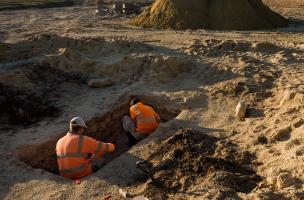
Horse burial: excavation in progress
© Denis Gliksman / Inrap
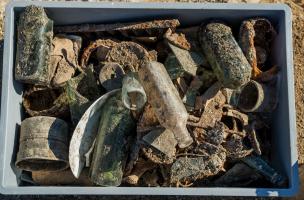
All artefacts 14/18
© Denis Gliksman / Inrap
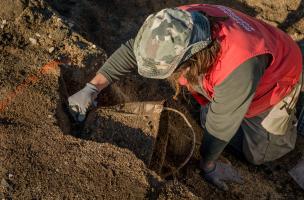
Excavation of a waste pit 14/18
© Denis Gliksman / Inrap
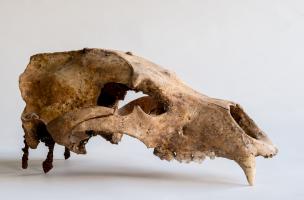
Bear skull with taxidermy marks (pins and nails inserted in the bones)
© Denis Gliksman / Inrap
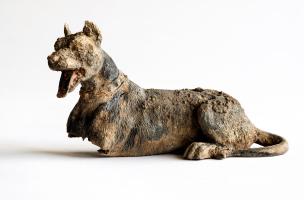
Small statue of a Great Dane in molded metal with traces of paint
© Denis Gliksman / Inrap
Barracks
Mahaut Tyrrell
Media communication
Inrap, media partnerships and relations
01 40 08 80 24
mahaut.tyrrell [at] inrap.fr

